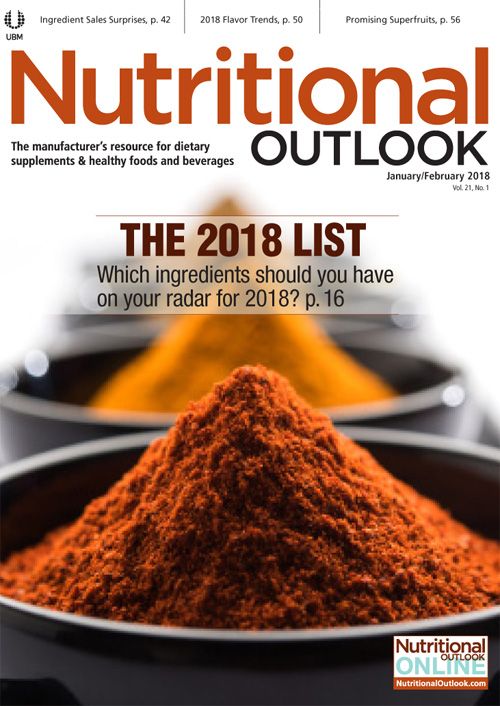2018 Ingredient Trends to Watch for Food, Drinks, and Dietary Supplements: Magnesium and Zinc
Supported by mounting cognitive-health research, magnesium and zinc are the minerals to watch this year.
Photo © iStockphoto.com/sasimoto

Watch out, calcium-there are two new minerals in town. Magnesium and zinc spent 2017 inching closer to calcium’s number one spot in the mineral supplements category, with data from SPINS indicating that sales for magnesium saw 7.9% growth over 2016, and zinc showing 29.7% growth over 2016 (SPINSscan Natural, SPINSscan Specialty Gourmet, Conventional Multi-Outlet [powered by IRI], 52 weeks ending November 5, 2017). With new research backing magnesium’s benefits for heart- and mental-health, and zinc’s purported immune-health benefits, as well as expansion into new market segments, 2018 may be a breakout year for these two minerals.
Last September, Nutritional Outlook spoke with company representatives from Balchem/Albion Minerals (Clearfield, UT) at the SupplySide West trade show about why magnesium and zinc are on the rise. Magnesium, in particular, is showing serious market growth, says Todd Johnson, senior director of marketing, human nutrition, and pharma, Balchem/Albion Mineral. “Although calcium continues to be the best performing mineral with around 40% of the market,” he says, “magnesium’s growth rate projects that it could overtake calcium’s position as the largest selling mineral by the year 2020.” According to SPINS, sales for magnesium as a standalone functional ingredient were $101,180,844 (up 7.9% over the past year), while sales for magnesium/calcium combination supplements were $78,525,572 (down 3.0% over the past year).
That’s no easy feat, to be sure, but Johnson says that interest in healthy-aging supplements, novel and convenient delivery forms, and “the expansion of sports nutrition products into active nutrition” are all key factors aiding magnesium and zinc’s ascent. As evidence of the latter, lozenges were the second most-popular delivery format for zinc at $11,155,099, experiencing a 38.3% growth over the previous year.
In addition, Johnson says, “magnesium is involved in nearly every major metabolic and biochemical process within the cell. Every organ has a critical need for magnesium in order to effectively perform their functions.”
Andrea Rosanoff, PhD, director of research and science information outreach, Center for Magnesium Education and Research LLC (Pahoa, HI), explains that there’s more information for consumers than ever before about magnesium deficiency, which is notoriously hard to determine. And that’s a big problem, she says, because a lack of magnesium can manifest in many scary ways. “Diabetes, heart disease, stroke, migraine, high blood pressure, pregnancy-induced hypertension, high cholesterol, cramps, aging, sleeplessness, depression, anxiety, respiratory issues such as asthma, and more,” she says, may be the unfortunate results of long-term magnesium deficiency.
Both Rosanoff and Johnson state that most U.S. consumers don’t get adequate levels of magnesium in their diets. Says Johnson: “Some estimates suggest that 80% of Americans are not getting enough magnesium.” With a large swath of the population seemingly at risk, the market is primed for a magnesium takeover.
And there’s no shortage of research in the pipeline. Rosanoff says that “tons” of recent research supports magnesium’s myriad health benefits, and not only for general wellness. “Proper magnesium intake can enhance exercise performance,” explains Rosanoff. “When magnesium is marginal and magnesium ‘stores’ are low…high-endurance exercise can be dangerous.”
Johnson says that sports nutrition is one category in which magnesium supplementation is really catching on. “Sports nutrition is definitely an area in which we are seeing increasing interest,” he says. “Minerals play important roles in counteracting the impact that exercise performance can have on the body. Magnesium and zinc play important roles in fighting against oxidative stress and reducing inflammation, thereby reducing muscle damage.”
In addition to sports nutrition, magnesium has also shown some preliminary promise in the fields of mental and emotional wellness. “While the mechanisms of the antidepressant actions of magnesium are not fully understood,” Johnson adds, “the mineral has been shown to influence several systems associated with depression.”
According to SPINS research, mood support was the health category for which magnesium experienced the most growth. It had $14,444,421 in sales, representing a growth of 17.9% over the previous year.
Zinc, too, has benefitted from new research on its potential benefits for cognitive health. Johnson explains that “zinc plays important roles in the function of the brain, including the ability to learn and increased memory,” and notes that zinc’s brain-health benefits may be another factor contributing to its increased popularity. Beyond the brain, zinc also possesses antioxidant and anti-inflammatory properties, and is currently being studied for its potential effect on child growth, wound healing, and even vision.
The top five health focuses for zinc, according to SPINS data, were cold & flu, menopause support, prostate support, general wellness, and cardiovascular health.
2018 Ingredient Trends to Watch for Food, Drinks, and Dietary Supplements:


.png&w=3840&q=75)

.png&w=3840&q=75)



.png&w=3840&q=75)



.png&w=3840&q=75)
























